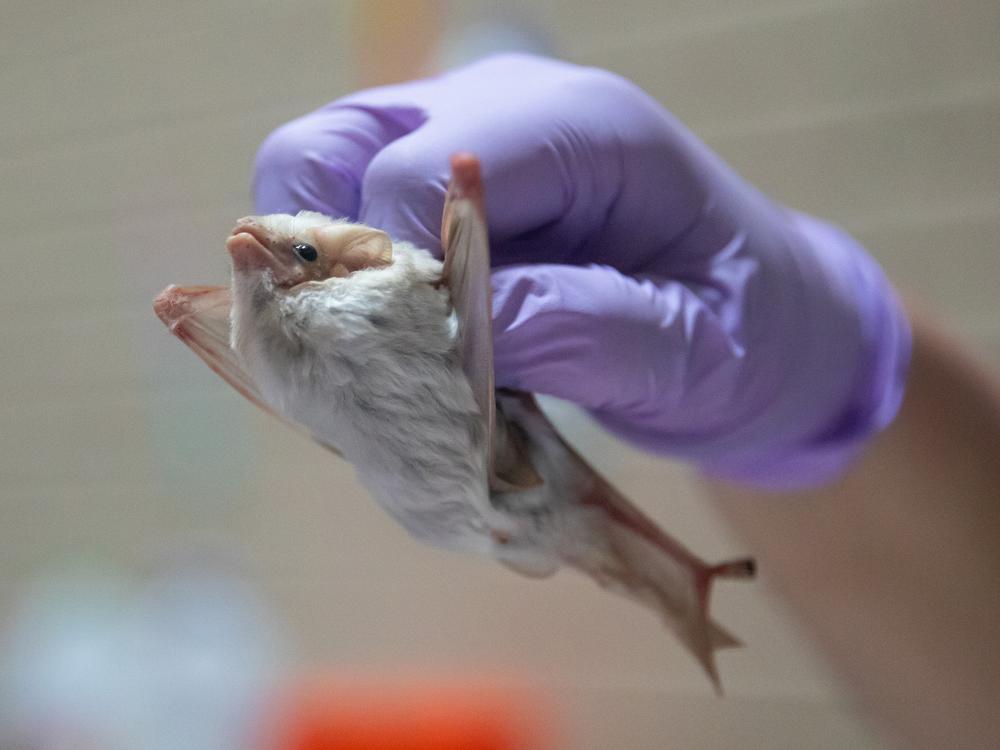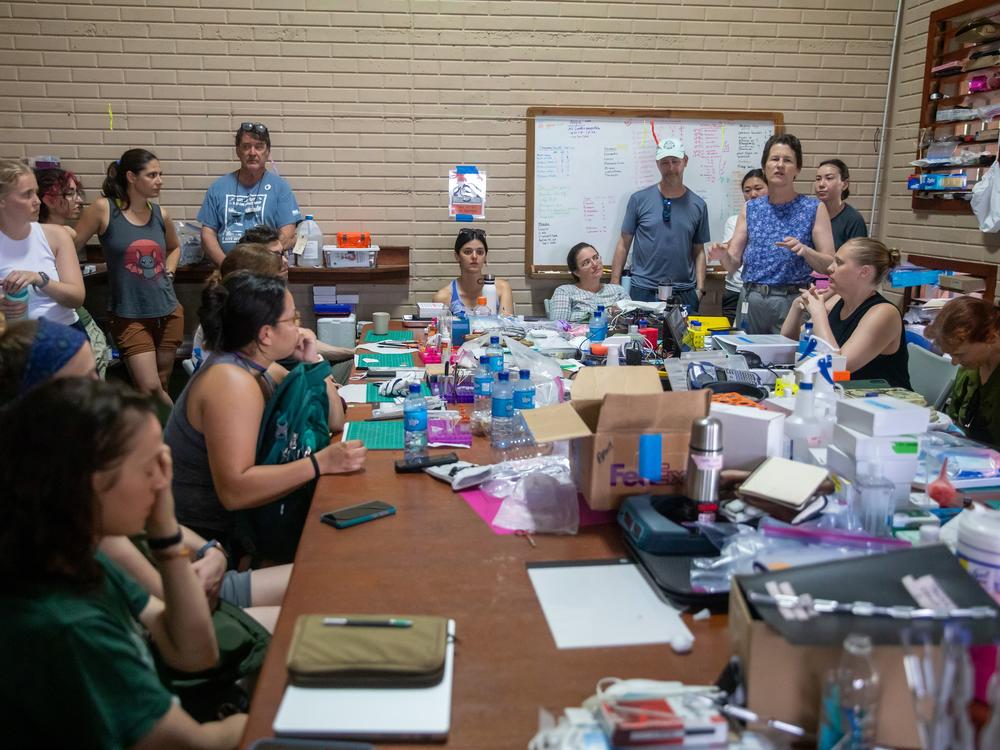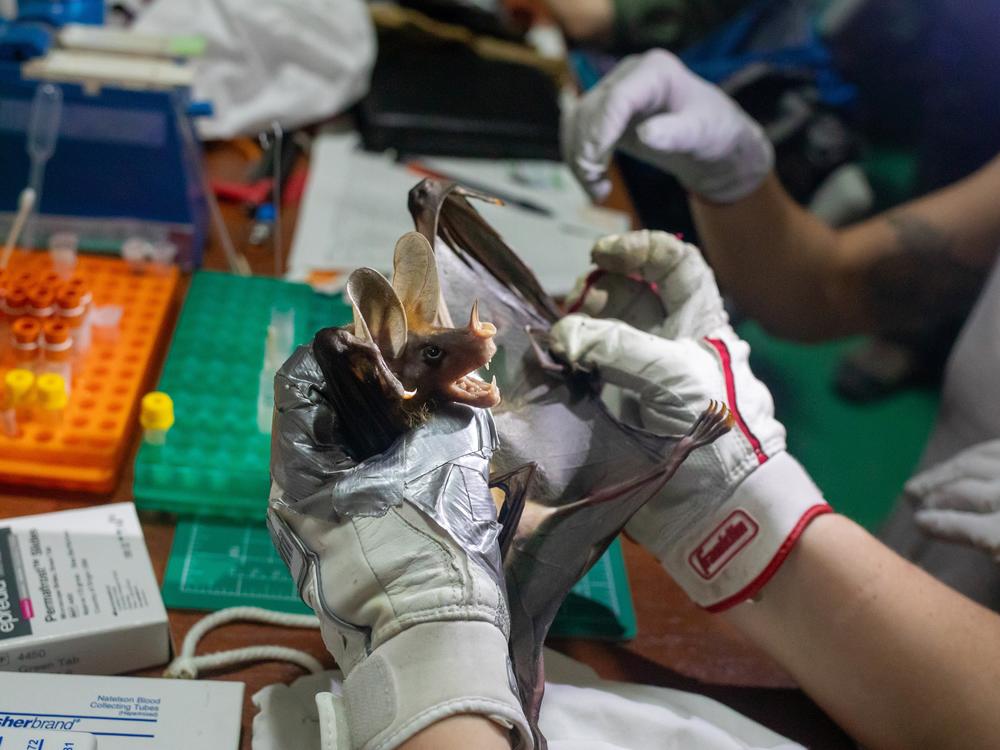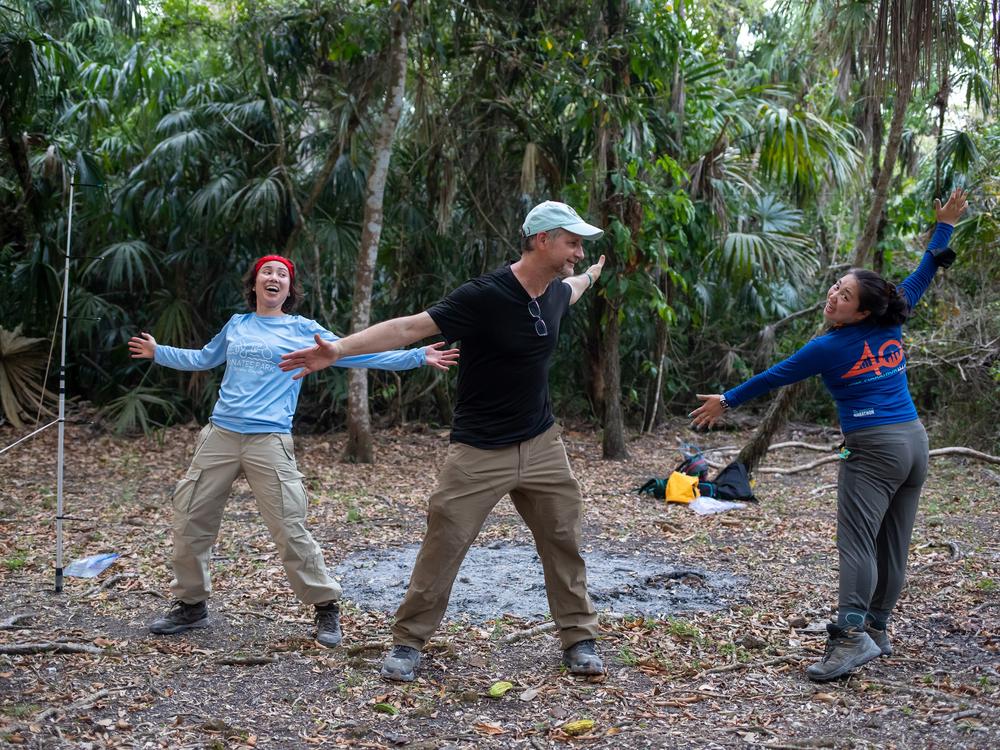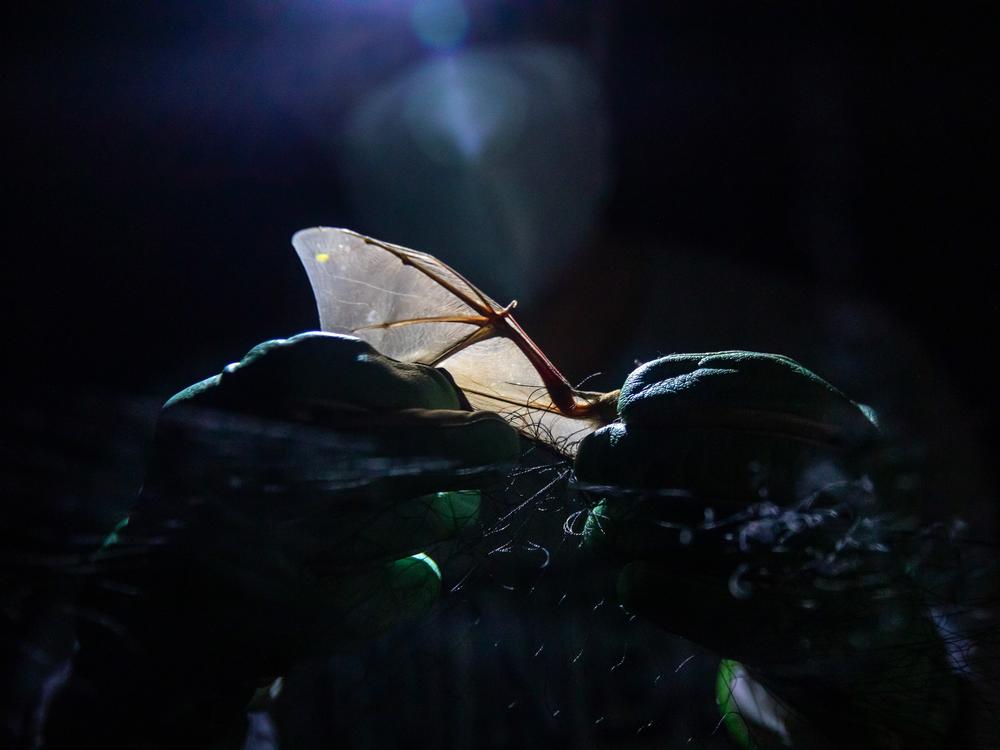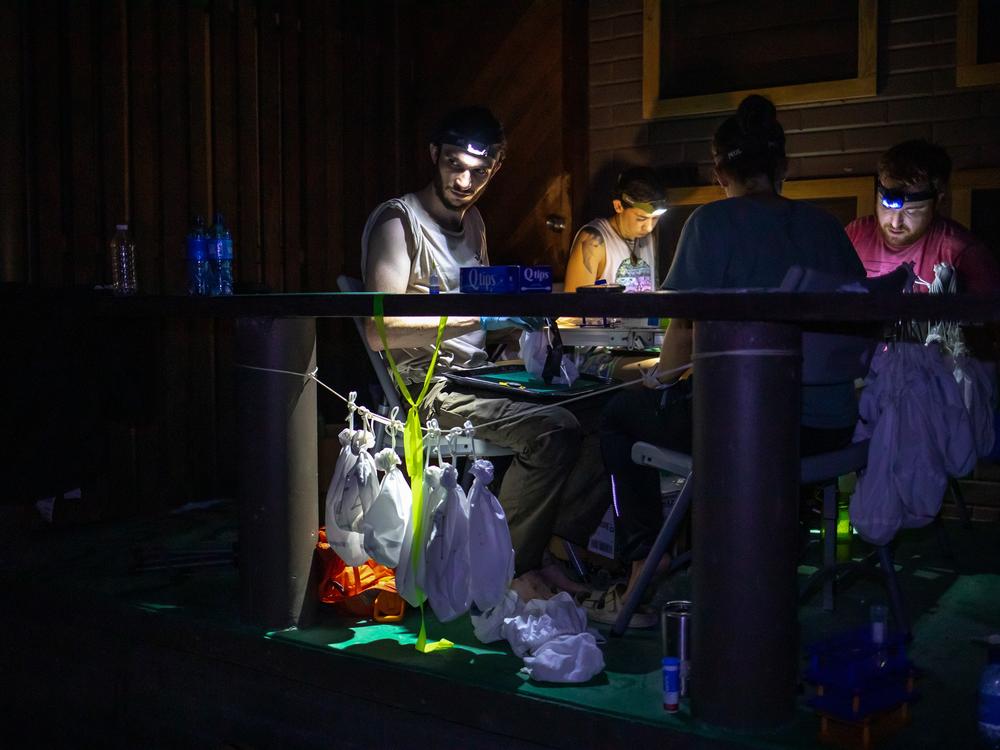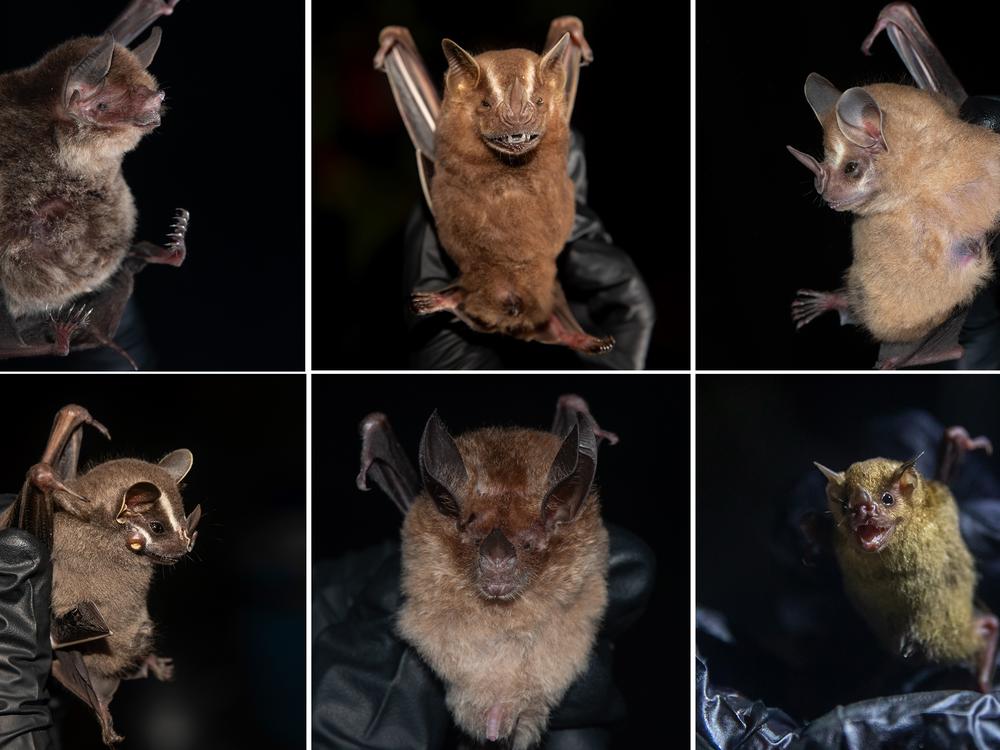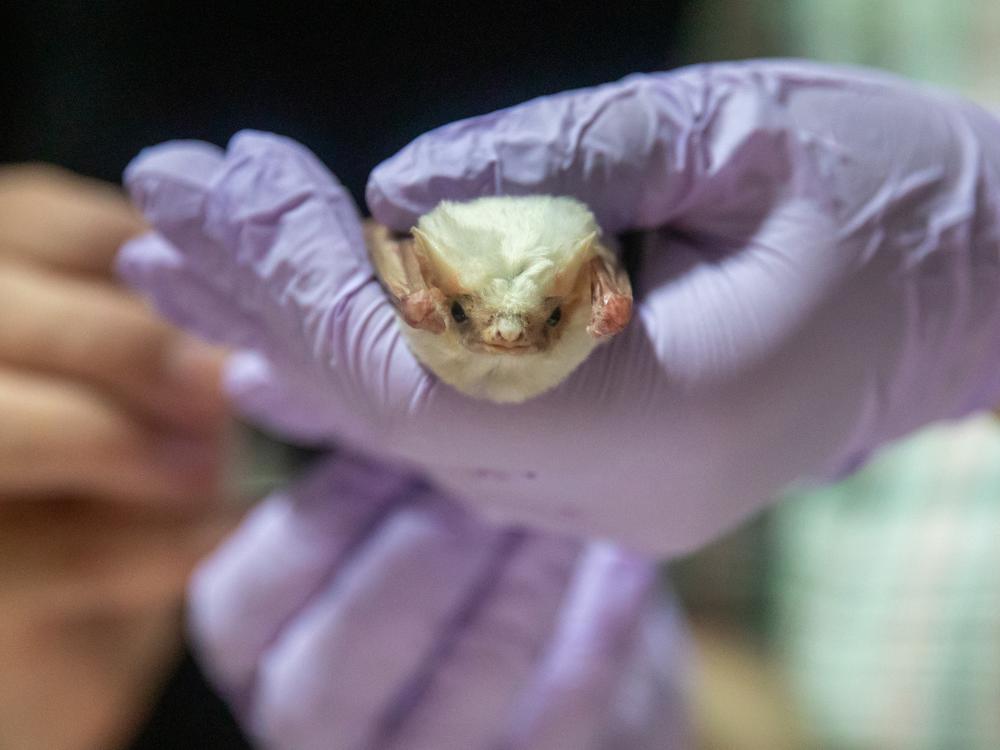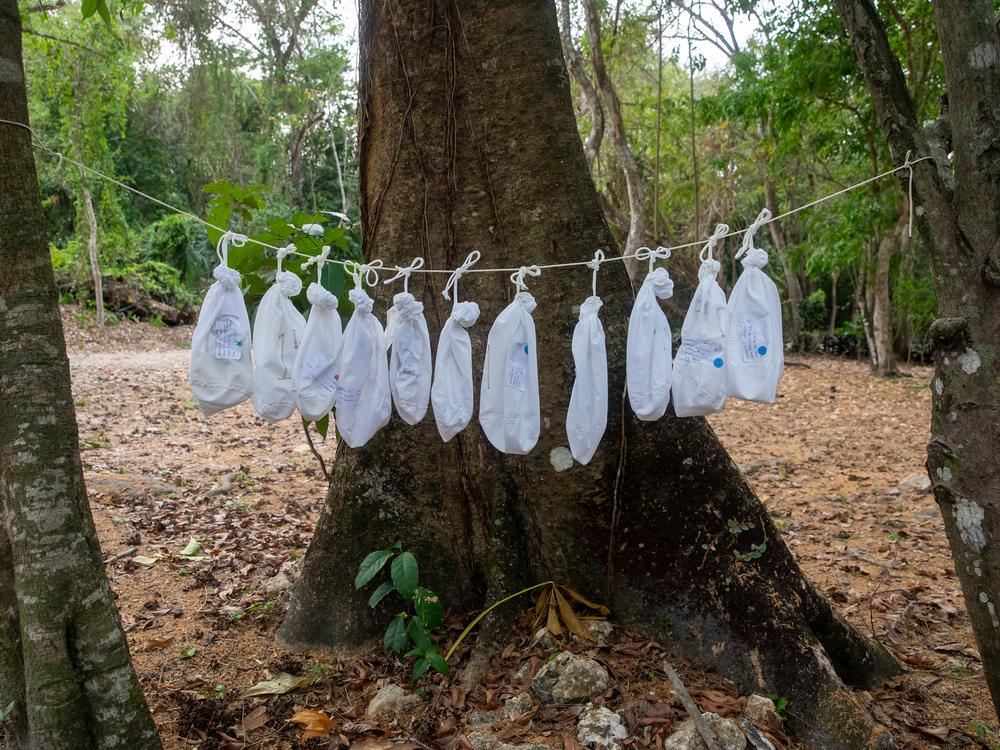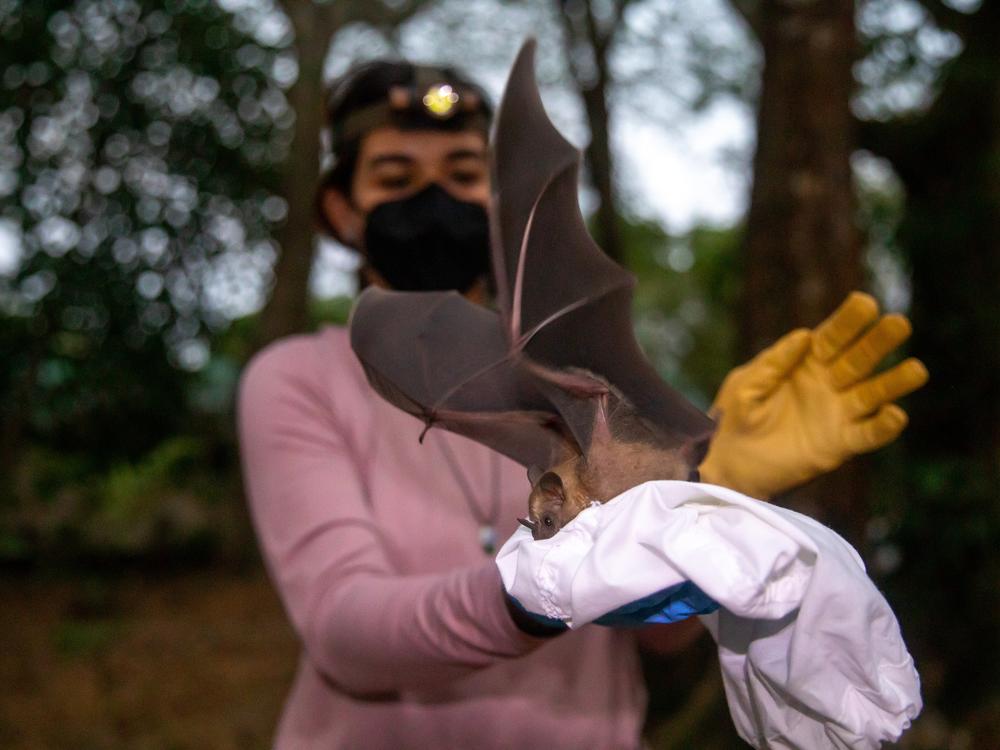Section Branding
Header Content
Bats are like riddles. The Bat-a-thon aims to solve them
Primary Content
It’s late in the day on a muggy spring afternoon in northern Belize. A couple dozen researchers enter the Lamanai Archaeological Reserve on foot. Their objective is to catch as many different kinds of neotropical bats as they can. With at least 75 species, this part of the world is a gold mine for bat diversity and an excellent place to study these flying mammals.
After walking for 20 minutes, the group splinters. A team of five or six stops paces away from a giant multi-story Mayan temple that surges out of the ground. A few turkey vultures perch atop this High Temple, which is more than 2,000 years old.
The team works quickly to erect a 25-foot-tall net designed to catch high-flying bats that eat insects. They place two long metal poles roughly 40 feet apart, stretch a large black net between them, and secure the poles with rocks and guylines.
The loud roars of howler monkeys in the trees above sweep across the researchers as they work. Alicia Roistacher, a biology graduate student at the University of Oklahoma, acknowledges the drama of the scene. "Setting up nets while the howler monkeys are just screaming above you," she says, "and there's Maya temples right behind us — this is amazing."
Roistacher is just one of the dozens of bat scientists and enthusiasts who converge on this patch of tropical moist forest in Belize every year for what’s become known as the annual “Bat-a-thon.” In a place that was once a Mayan metropolis, this group comes to study what these little nocturnal riddles have to teach us about our changing planet — and ourselves.
A science oasis
The Bat-a-thon is now in its sixteenth year. It’s grown from a gathering of about 25 people to — this year — 80 researchers and helpers from 50 institutions and 15 countries. “There are no papers, there are no presentations, there’s no posters,” explains Brock Fenton, a retired biologist at Western University in Ontario, Canada, who founded the Bat-a-thon. “It’s people studying bats and talking about bats.” Compared with a traditional scientific conference or meeting, Fenton says, “it maximizes interaction.”
Nearly everyone gets a room at the Lamanai Outpost Lodge, located on the banks of a lagoon along the New River. The remote lodge becomes a residential laboratory for two weeks. “There’s nobody staying here except us now, so everybody here is a bat person,” says Nancy Simmons, a curator of mammalogy at the American Museum of Natural History in New York and the person who currently runs the Bat-a-thon.
The team eats their meals together, works to catch bats in the field, and then studies them back at the lodge — in a classroom-turned-lab, outside on the porches of the cabanas, and inside a flight tent out past the generators. The annual gathering has yielded nearly 90 academic papers over the years.
“We have complex whole research programs,” says Simmons, “studying things about bat biomechanics — how they fly, how they land — bat behavior, bat ecology.” The benefit of a long-term study site like this is that the scientists have deepened their understanding of where these bats live, roost and travel. Every project is able to build off of this foundation.
And there’s no shortage of compelling research questions to ask. “Everything you would think to attribute to a mammal, they kind of do the opposite,” says Keelyn Kotecki, a research biologist at Southern Connecticut State University.
This field season, for instance, one research group is studying the natural ability of fruit bats and nectar bats to comfortably feast on large quantities of sugar — amounts that would put a human being in a diabetic coma or kill them outright. The scientists are curious to see whether the bats’ capacity to handle high sugar levels in their blood may point to treatments for people with diabetes and other metabolic disorders.
Some bats stay healthy even when carrying pathogens that would make humans sick. So another project is using a new sampling technique that requires a single drop of bat blood to examine how different species cope with infections and how altering their habitat impacts their immunity. The researchers want to know if some bat species are more tolerant of infection than others and why some bats are able to harbor more virulent pathogens. Such information may help prevent the spillover of deadly pathogens from bats into people in the future.
Yet another researcher is looking into whether bats are as specialized diet-wise as we’ve long thought. Might a nectar-eating bat, for instance, sometimes dine on insects? It’s a question with conservation implications in terms of how vulnerable bats are as their habitats (which contain their preferred foods) are eroded by human encroachment and development. And if bats are indeed able to expand or alter their diets, it would inform recommendations for how best to harmonize human activity on the landscape.
“The more we learn about [bats], the more open questions there [seem] to be,” says Phillip Oelbaum, an ecology Ph.D student at the University of Toronto. “It’s a never-ending well of really cool science.”
It’s this combination of community and good science that keeps her coming back year after year. “It’s really fun. I love it,” Simmons says. “There’s nothing like this event anywhere else in the world.”
It's 'bat time'
Jessica Montoya, a biology graduate student at the University of Illinois at Chicago, says that dusk marks a critical moment of transition when the world crosses over into a kind of dark side that everyone here is addicted to.
“During the day, it’s bird time,” she says. “You can see the birds all around.” And it’s true — there are green herons, kingfishers, mangrove swallows, northern jacanas, snail kites and more.
“But then there’s a point in sunset where it stops being bird time and it starts being bat time,” says Montoya.
At last, among the Mayan ruins, the remaining daylight leaks out of the sky.
Bat time has officially arrived.
Behind the High Temple, there’s a wide path, which acts as a kind of bat flyway. This is where some of the researchers have set up a series of nets at eye level — like an aerial obstacle course for the bats.
“They just zoom past here so quickly, even when we’re sitting around waiting for them to get into our nets, we just watch them flying all around us,” says Jasmin Camacho, an evolutionary biologist at the Stowers Institute for Medical Research in Missouri. She sits off to the side, waiting. It doesn’t take long for the nets to do their job.
Camacho notices a couple of people gathered around one of them. She stands up and switches on her headlamp. “Let’s go check out what they got.”
A little nectar-feeding bat has entangled herself in the net. With her wings folded up, her body’s no bigger than a hard-boiled egg. Camacho and Ann Froschauer extract the bat carefully. Froschauer is with the U.S. Fish and Wildlife Service but is in Belize on her own time and dime.
“Once you have most of the wing free,” Camacho confides quietly, “the rest should just slide away.” Froschauer methodically works to extricate the bat from the net. “Hang on,” she says. “The tip of her wing on this side is still tucked in a little bit.”
At last, she’s free. Camacho holds the bat in her gloved hand. Froschauer scans her for a small PIT tag, the same kind that people use to microchip their pets. Here, every bat that’s captured receives one of these tags to keep track of them over time. This particular bat doesn’t have one, so she hasn’t been caught before. Camacho places her in a small cloth bag.
Next, the team catches an insect-eating mustached bat that’s small enough to fit in the palm of Camacho’s hand. The team slowly disentangles him, too. They then admire him. “So handsome,” says Camacho. “You’re a cutie,” says Froschauer.
At this point, the bats are hitting the nets one after another. Within a couple hours, the teams have pulled dozens of them out of the air. Some researchers use crochet hooks to help with the extractions.
The bats wait patiently, each in a cloth bag (which Simmons purchases, custom-made, from a small sewing shop in her hometown in New Jersey). Some are the color of dark chocolate. Others look like fuzzy caramels.
“We get a lot of common species,” says Camacho. “But the more nets we set out, the more chances we have to catch something rare and special. And so for us, those are like finding the rare Pokémons of the sky — just trying to catch them all if we can.”
The night before, the team snagged one of those special Pokémons — a small northern ghost bat. “With white fur, transparent wings,” Camacho says. “Those are so rare to see. It was magical. We were almost crying looking at this beautiful animal ‘cause we were just so in disbelief that we actually had it.”
Another evening, one of the teams nabbed a spectral bat, an animal with a three-foot wingspan. It was such an exciting capture that a couple dozen researchers waited expectantly as it was taken out of its bag, their phone cameras at the ready.
In the bags — literally
Eventually, the researchers and helpers walk the bats in their bags back to the makeshift lab at the lodge. “It’s a hive of activity,” says Fenton. More than a dozen chairs encircle a giant table filled with notebooks and calipers.
At the far end of the room, the bat bags hang from a string stretched between two of the walls. This is where Elizabeth Clare is positioned. She’s a molecular ecologist at York University in Toronto and it’s her job to confirm the species identifications of all the bats using physical characteristics like body size or the presence or absence of tail membranes. “We look at the measurements of forearms and tibia,” she says. “Sometimes you go searching for tiny little teeth buried at the back of their gums” — teeth that are smaller than grains of sand.
Clare pulls out a small cinnamon-colored bat to demonstrate her technique. It’s got a pair of parallel streaks above and below its eyes, a stripe running along its back, and a tuft of furry fringe near its tail, “Where we are here in Belize,” she explains, “there’s about six bats that have the stripy face, two that have the line down the back, but only one also has the fringe. And that’s how I do it, so that I know that that bat here is Platyrrhinus helleri.”
By the end of the two weeks, Clare will have confirmed the IDs of all 1,132 bats that were captured (38 species in total this year). These identifications are important for determining which kinds of bats are found in this part of Belize, and many of the projects here rely on accurate species information. That’s because most scientists are interested in particular types of bats to answer their specific research questions. In addition, over the years, the Bat-a-thon has documented some species of bats showing up in this part of northern Belize for the first time, allowing the team to extend the home ranges of these animals.
The researchers can take the bats they’re interested in studying and run their experiments into the wee hours of the night. At some point, the animals get something to drink.
It’s not uncommon for people here to go to bed pretty late. But there are a few individuals who try to turn in early. That’s because before sunrise, it’s their job to release the bats back into the waning night.
Neil Duncan, a collections manager with the American Museum of Natural History, is one of those people. “They are live animals we do care about,” he says. “They’re released unharmed.”
One early morning, he stands inside the archaeological reserve, a couple dozen bat bags hanging from his fingers. He selects one of the bags.
“I just unfurl the bag a little bit,” he says, almost whispering. “You see the bat. He sees freedom.” The bat leaps into the air. “And he’s gone.”
That was a small vampire bat. Next up is a little fruit bat. It too soars off, its encounter with the big apes now concluded.
“This is fun,” says Duncan. “This is part of the joy that once you’ve captured these bats, and now you send them back.”
One by one, the bats return to their mysterious batty lives. Later, the sky begins to brighten.
The soundtrack shifts.
It’s bird time again.
